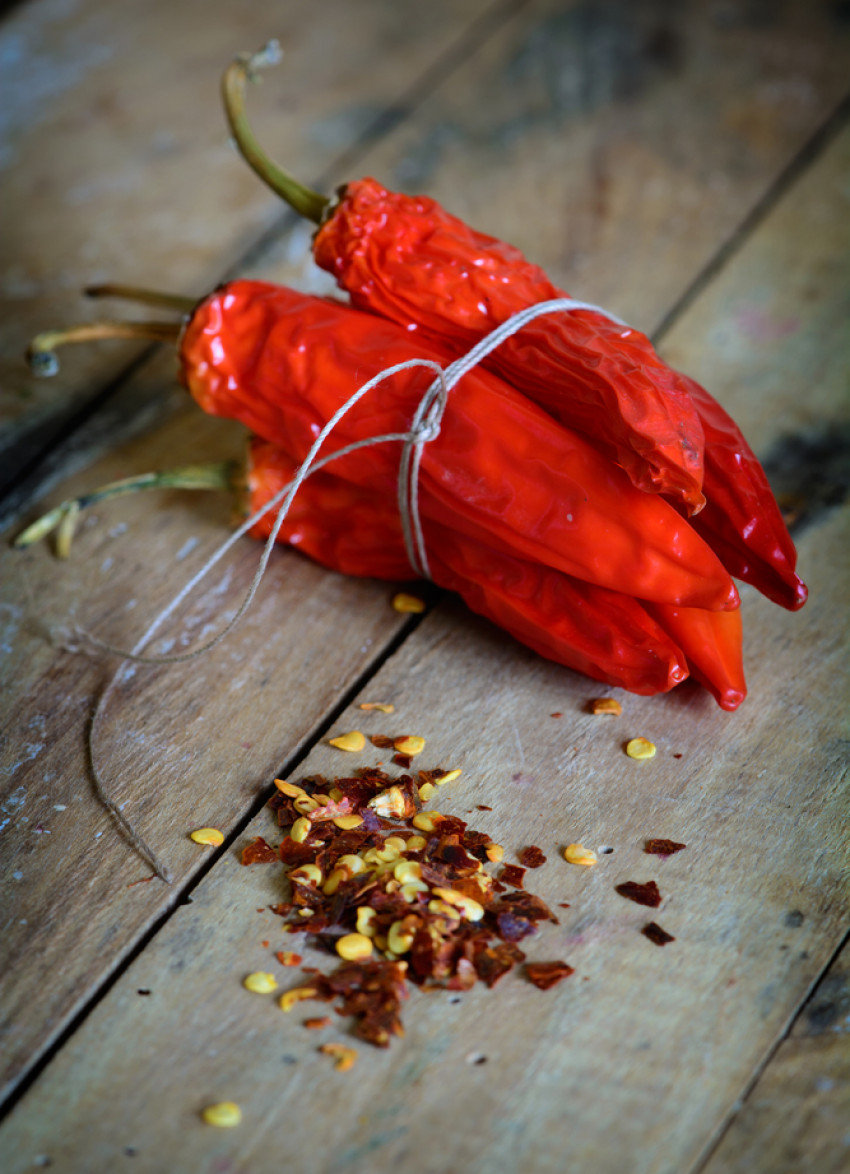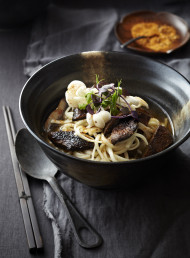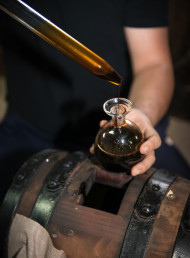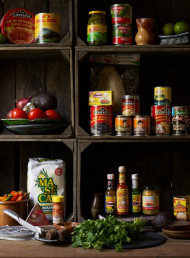A guide to: chillies

Don’t be deterred by their fiery natures – chillies can add a world of flavour to your cooking, as Sarah La Touche explains.
Where do you start with chillies? With flavours that range from sweet to pleasantly warm, through to eye-wateringly hot they can also change personalities when dried or fresh. How do you prepare them, or know which chillies work best in which dish? It’s a hot and spicy minefield.
Chillies are a member of the nightshade (Solanaceae) family, and therefore related to the tomato, eggplant and potato. Native to the Americas, they have been enjoyed for centuries, eaten in great quantity or used sparingly as a condiment. So many cultures embrace chillies in their cuisine that it is now the most widely grown spice in the world.
Not all chillies are created equal though. Capsaicin, the pungent chemical that gives chillies their heat, varies greatly from plant to plant and even fruit to fruit, which is why you get different levels of heat and pungency depending on the variety.
Capsaicin resides on the surface of the chilli’s ‘placenta’, the soft, slightly oily-feeling membrane where the seeds gather. The seeds actually contain little heat, except for those that have been in contact with the membrane’s volatile oils.
As you eat a dish containing chilli, the degree of heat may impact on different parts of your mouth. It can be quick and biting, building slowly to become persistent and intense – even numbing – or just produce an agreeably warm glow. The effect will depend on the variety of chilli, the condition of the fruit, or the climate in which it was grown. For example, a jalapeño grown in a hotter climate is likely to be fierier than that grown in a cooler climate.
The heat in chillies is measured in Scoville heat units (SHU). The capsaicin is extracted, diluted and its pungency measured. The more dilute and pungent the extract the hotter the chilli and the higher it rates.
You can employ as a general guideline that the smaller the chilli the hotter it is. Or the broader its circumference, the milder it will be. But there are some exceptions, so watch out. A chilli’s heat is less intense toward the bottom of the fruit, rather than at its fiery centre. And as capsaicin is fat soluble not water soluble, it can be useful to wear gloves during preparation, avoiding contact with eyes, nose, under fingernails and any other sensitive areas of the body. To stem a burning mouth or skin, milk, yoghurt or ice cream is useful in relieving temporary discomfort, which should subside after about 10 minutes.
When preparing chillies, cut them in half down the length of the fruit, using a sharp knife. Remove the membrane and the seeds from each side and discard. If you like lots of heat remove the seeds but leave the membrane. Cut off the stalk. The two halves can then be cut in fine strips lengthways, then across the width of each half to create fine, even dices – an ideal way to prepare them for salsa. They can be ground to a paste in a mortar and pestle or food processor for pastes and sauces.
In the case of some very hot chillies, like those from the habanero family, cook them whole to keep their full-throttle heat from escaping and overpowering a dish. Dried chillies can be soaked, crushed, flaked, pounded, or ground to a powder and used to flavour many different dishes, or sprinkled over food after cooking as a condiment instead of pepper, as is the case with Basque Espelette pepper. In India chilli can be used in one dish in its fresh, dried and flaked forms.
Capsaicin, the pungent chemical that gives chillies their heat, varies greatly from plant to plant and even fruit to fruit.
Green chillies are no less hot than red, in fact their pungency is about the same. What does differ is their sweetness, with green chillies offering a more bitter flavour profile.
There are five main species of chilli, each with its own distinct features, flavours and levels of heat. Given the enormous range of chillies available, I have focused on the more commonly available varieties, all of which are grown in New Zealand.
From the Capsicum annuum species – mild to hot:
Anaheim (also known as Mexicana, New Mexican) is a biggish, long chilli with a waxy-looking pod. They can be used green or red but are most commonly eaten fresh and green. Great for stuffing, roasting, grilling on the barbecue, or mincing for sauce. When ripe they can be dried and powdered. Heat scale: Mild. 500 – 2000 SHU
Cayenne(also known as Asian Green, Mexican Red) is the most commonly grown chilli in New Zealand with long, gently curving, finger-like pods. Used red or green they are easy to cook with because of their fine skin. Good for pickling, in sauces or to dry. Once dried they can be ground finely to make cayenne pepper or coarser chilli flakes for sprinkling over pizza, grilled meats and fish, vegetables and pasta, or added to sauces and stews. Heat scale: Medium – hot. 30,000 – 50,000 SHU
Jalapeño is perhaps one of the most famous chillies we know. This slightly chubby, conical fruit with a distinct pointed end ripens to a deep red, developing fine cracks on its skin like pottery crazing. With a sharp bite it can be eaten green or red and is great pickled and sliced into nachos, deep-fried in batter and served as a nibble or stuffed and baked. When smoked and dried it is called chipotle and used for making tangy barbecue sauce. Dried chillies are best soaked for an hour or two before being used to make a base for hot sauce or as a condiment. Heat scale: Medium – hot. 2500 – 10,000 SHU
Paprika (also called Pimento in Europe) is a chilli with pods that colour to scarlet red when ripe. They can be used fresh, often sliced into salads, but are most commonly used dried and ground to a fine powder for seasoning sauces, braises and stews. Heat scale: Mild. 100 – 2000 SHU
Poblano is a largish fleshy pepper with a rough triangular shape, indented crown and pronounced pointed tip. They can be eaten green, and are especially delicious brushed with oil, grilled and salted on the barbecue. This chilli is called Ancho when dried and is synonymous with the Mexican dish ‘Mole’ once dried and ground to a powder. Heat scale: Mild to medium. 1000 – 1500 SHU
Serrano is a small, compact chilli about five centimetres in length with a smooth skin and fresh tangy flavour. A close relation to the jalapeño, it’s ideal for eating fresh either green or ripe, in salsas, dipping sauces, guacamole or any number of Asian dishes. Heat scale: Hot. 10,000 – 20,000 SHU
Wax (also known as Hungarian Hot Wax, Bananaor ‘Guerro’) This group of chillies has a waxy, smooth appearance as the name suggests, and are yellow in colour. Their shape varies from quite small to large, long pods (up to 20 cm) with an unpronounced tip. Their pungency varies too – the milder versions can be sliced into salads or stuffed and baked. The spicier fruits are commonly pickled or minced for sauces. Try these when making a yellow Mole sauce. Heat Scale: Medium – hot. 0 – 40,000 SHU
From Capsicum frutescens species - getting hotter…:
Tabasco (also known as bird pepper) was made famous by the sauce of the same name. The stunning fruit can be yellow, orange or green when unripe, turning to a flaming red when mature. It is a smaller chilli, around 3.5 cm, and on the fiery side with a dry, smoky flavour. Use it for sauces, hot pickles, and adding spice to braises and stews. Heat scale: Hot. 50,000 SHU
Thai Hot or Bird’s-eye is a searing hot, tiny chilli in either green or red that can be as small as 1 mm and up to 3-4 mms, with a distinct pointed tip and thin stem. Sold either fresh or dried in many Asian food outlets, it is the perfect chilli for making Thai curry pastes, sambal, laksa, tom yum soup and hot Thai salads. Heat scale: Very Hot. 50,000 – 100,000 SHU
Thai long red/green is in the same family as the bird’s-eye, and these thin, longer chillies with a slightly wrinkly skin and pointed tip are almost as hot. Use them green or red. Ideal for stir-fries and most Asian dishes that require a little kick, like chilli squid or prawns. They can also be minced for making sauces and pastes. Remove the membrane to lessen the heat. Heat scale: Medium – hot. 50,000 – 80,000 SHU
From Capsicum baccatum species – very hot:
South AmericanAji or Escabeche. Ranging from green to orange-red, this long, fleshy, pungent pepper is best used in sauces and not very common in New Zealand. Heat scale: medium – hot. 30,000 – 50,000 SHU
From Capsicum pubescens species – extremely hot:
Rocoto (also known as Caballoor Manzano) is small, round and apple-shaped with distinctive black seeds. The fruit colours to yellow, orange or red. This fleshy, thick-skinned pepper packs a deceptive punch. Use fresh for salsas and sauces. Not suitable for drying. Heat scale: Very Hot. 30,000 – 60,000 SHU
From Capsicum chinense species – hotter than hot:
Habanero, Scotch Bonnet, Paper Lantern prove the exception to the rule about size and heat. While not as small as the Thai birds-eye, the habanero family is amongst some of the hottest chillies around. Short, squat and slightly misshapen, these can be eaten when yellow, orange or red. Their fragrant tropical flavour is distinctive, briskly followed by a wall of clean, searing heat. Toasting or roasting will release the piquancy even more. Chop raw into fresh relishes, salsas and sambals, or reign in their powerful punch by adding whole to stews, braises and casseroles. The Scotch Bonnet is the flavour behind many spicy Caribbean dishes. Mince them for pastes and sauces. Always treat these varieties with respect and use gloves during preparation; they can blister skin and tongues. Heat scale: Very, Very Hot. 50,000 – 300,000 SHU
latest issue:
Issue #120
As the days become shorter, and the nights cooler, the latest issue is perfectly timed to deliver delicious autumn dishes. From recipes using fresh seasonal produce such as feijoas and apples, to spectacular soothing soups and super-quick after-work meals in our Food Fast section, we’ve got you covered. With Easter on the horizon, we feature recipes that will see you through breakfast, lunch and dinner over a leisurely weekend holiday, and whip up chocolatey baking treats sure to please. We round up delicious dinners for two and showcase a hot new Korean cookbook before heading south to Dunedin to check out all that’s new in food and dining.The latest issue of dish is on sale NOW at all good bookstores and supermarkets – don’t miss it!





